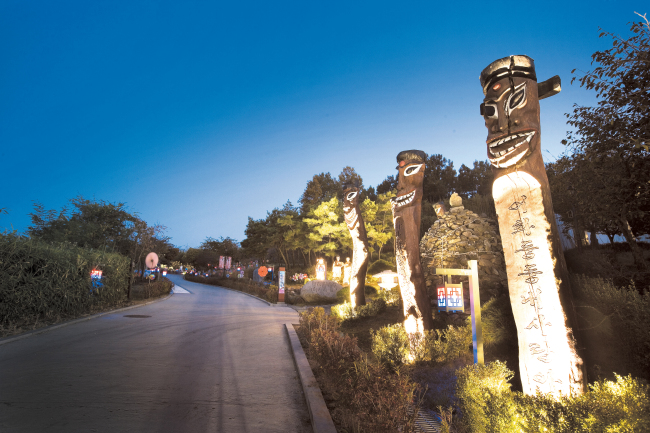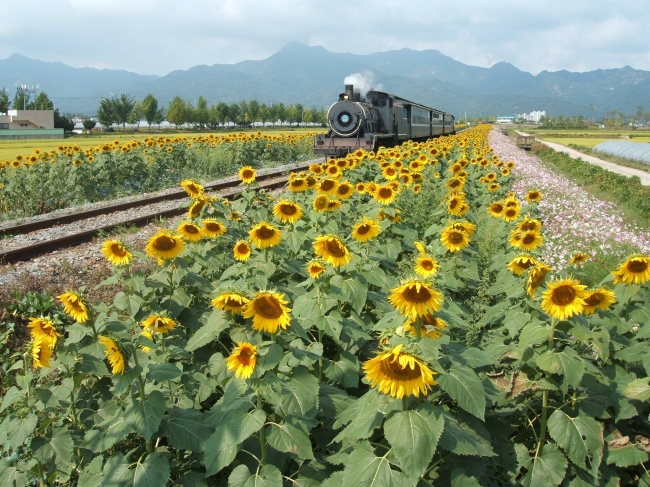Mount Jirisan offers stunning scenery from every peak and ridge, but also holds a trove of unique culture and rich tradition well preserved for centuries. The biggest mountain range in South Korea sprawls across seven cities and counties in the Jeolla region and South Gyeongsang Province. Hikers visit there year-round to appreciate its majestic peaks, the highest of which towers 1,915 meters above sea level, and to tread trails that weave in and out of the foothills of the mountain.
The popular 274-kilometer Jirisan Dullegil trail is divided into 22 sections that range from 9 kilometers to about 20 kilometers in length. Each trail takes hikers to one village after another, treating them to diverse cultural, artistic and culinary heritage.
Namwon, where the trail starts, is known for the traditional Korean folk music pansori and as the setting of “Chunhayngjeon,” a classical love story from the Joseon Dynasty that is still enjoyed by many readers. People visit Namwon to take a look at some symbolic places such as Gwanghalluwon, a garden built in the 15th century, which appears in the background of the novel.
The Chunhyang Theme Park preserves the artistic heritage of the novel in the form of pansori and events. The Namwon Chunhyang Festival, held each May, commemorates the spirit of the characters’ unwavering love and stages traditional music and performances.
 |
Chunhyang Theme Park in Namwon |
Jangsu is another region associated with a tragic true story ― that of Nongae, a woman whose husband was killed by Japanese invaders in the 1590s. To seek revenge, Nongae disguised herself as a female entertainer, lured a Japanese general to a cliff, embraced him and jumped with him to their deaths. She is honored for her act of patriotism at the Nongae Shrine. Nongae’s birthplace is well preserved and open to the public.
The county is also famous for good-quality Korean beef and apple, two local specialties that are highlighted with a festival a week before Korean Thanksgiving Day. The Jangsu Hanurang and Sagwarang Festival offers a variety of programs that invite visitors to taste local food and participate in folk activities.
Gokseong presents a mix of tradition and outdoor activities. It is home to two famous Buddhist temples: Dorimsa Temple and Gwaneumsa Temple, which date back to the Silla and Baekje kingdoms. On the old railway, out of official service, runs a steam train along the Seomjingang River. Round-trip tickets are 6,000 won for adults and 5,500 won for children and seniors.
 |
Seomjingang River Train Village |
 |
Nogodan Peak of Mount Jirisan commands a breathtaking panoramic scenery. (Mount Jirisan Tourism Development Association) |
Gurye boasts beautiful landscapes. In spring, the Gurye Sansuyu Festival invites visitors to the field of yellow Sansuyu flowers. Nogodan Peak, dubbed the “Sea of Clouds,” overlooks the most outstanding view of Mount Jirisan. Hwaeomsa Temple, the biggest temple in the Mount Jirisan region with the largest number of artifacts, is located on the southwestern corner of the mountain. Built during the Silla Period (B.C. 57-A.D. 935), the temple is on the way to Nogodan Peak. It runs a temple stay program available for 30,000 won for adults and 20,000 won for adults.
Hadong boasts optimally preserved historical sites such as the stone park Samseonggung, or three Sages Palace, Ssanggyesa Temple and the residence of the Choi family who appeared in the famous epic novel “Toji (The Land).” Hwagae Village, named as such because flowers bloom there, offers a breathtaking view of a 5-kilometer riverside street lined with cherry blossom trees.
 |
Mitten crab soup in Gokseong |
Near Hwagae Market sits a cluster of local restaurants serving mitten crab broth or chamgyetang, crab soup made with a locally caught freshwater crab.
Hadong, known as the first tea plantation field in Korea, still grows tea in a traditional way. Its tea is considered high quality and is sold at high prices. The traditional tea farming is celebrated during the Hadong Wild Tea Cultural Festival where visitors are treated to tea-making and tea etiquette sessions.
Sancheong is the venue for the World Traditional Medicine Expo, which is Korea’s largest showcase of Korean medicine. Visitors to the Sancheong Oriental Medicine Theme Park will be able to understand key principles of the Korean medicine, medicinal herbs and natural remedies using the herbs. The local Sancheong Medicinal Herb Festival introduces herbs collected in Mount Jirisan. Visitors can taste Oriental medicinal cuisine and also try herbal remedies at reasonable prices.
The Hamyang region is well known to locals and foreigners for wild ginseng. The Hamyang Wild Ginseng Festival promotes the locally grown ginseng and medicinal herbs. Visitors are invited to make wild liquor and rice cakes with the locally produced ginseng.
Information on the Mount Jirisan Dullegil trail and seven cities and counties that surround the mountain can be found on the mobile application Jirisan Dullebogo Smart Tour Guide. The application is available at the App Store and Android Market.
For more information, visit www.jirisantour.com or facebook.com/Jirisan2014.
By Lee Woo-young (
wylee@heraldcorp.com)











